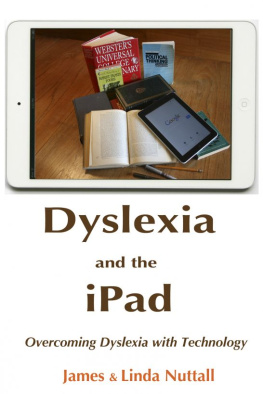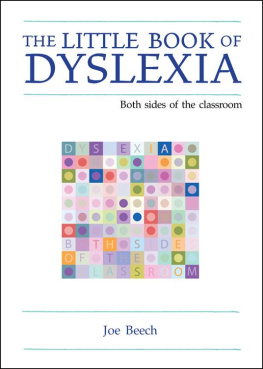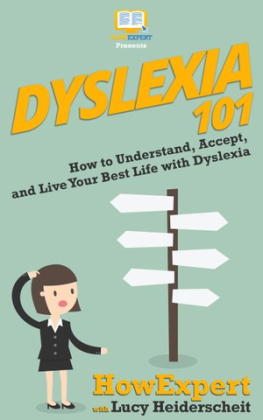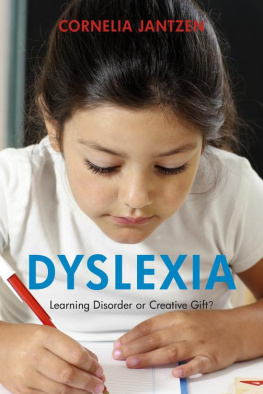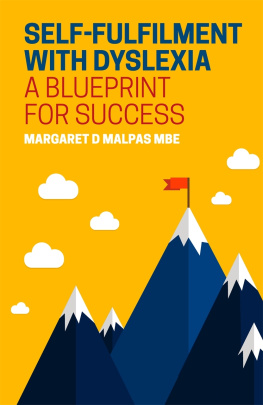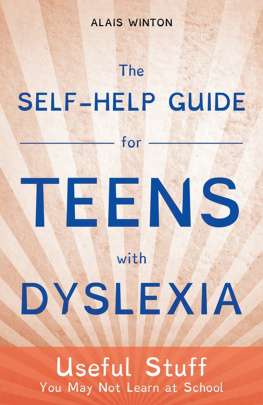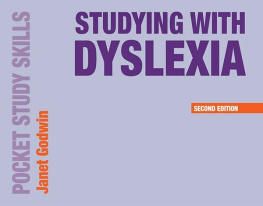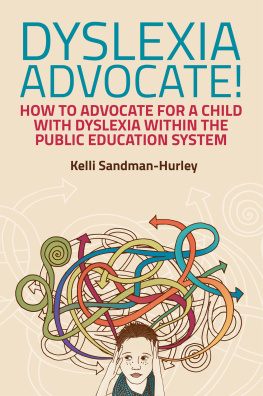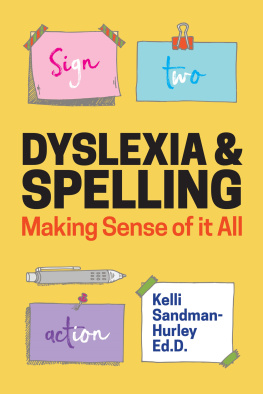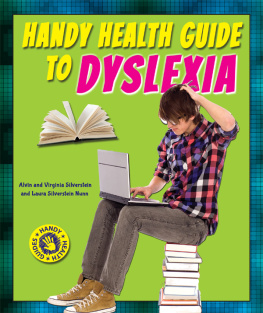Dyslexia and the iPad
Overcoming Dyslexia with Technology
James and Linda Nuttall
Published by JamesNuttall at Smashwords
Copyright 2013 James Nuttall
Smashwords Edition
License Notes
This ebook is licensed for your personalenjoyment only. This ebook may not be re-sold or given away toother people. If you would like to share this book with anotherperson, please purchase an additional copy for each recipient. Ifyou are reading this book and did not purchase it, or it was notpurchased for your use only, then please return to Smashwords.comand purchase your own copy. Thank you for respecting the hard workof this author.
Dyslexia and theiPad
Overcoming Dyslexia With Technology
Introduction
Sharing Lessons from Life
Hello, we are Jim and Linda Nuttall. We wish towelcome you to our book. This book is about Jim, his dyslexia andthe iPad. Linda has provided very helpful writing assistance. Whenspeaking using I, we are referring to Jim.
I am dyslexic. While growing up, I knew that Ihad a reading problem. During elementary school and high school, Iwas basically a non-reader. Every day, I watched my family andfellow students read books, magazines and newspapers. I longed todo the same. When I went away to college, I visited the Universityof Chicago Reading Clinic. At this clinic I learned that I haddyslexia. I persevered with college and earned a PhD in Psychologyfrom Michigan State University.
Over the years, I learned some tricks for copingwith dyslexia, many of which are enhanced by recently developedtechnologies. I would like to pass these tricks on to you. If youor your child has dyslexia, I hope you find this book helpful. Youdo not need to read it from front to back. You can skip around,reading what you like.
Why the iPad
Steve Jobs called the iPad a revolutionary andmagical device. It is unlikely that Steve and others at Appleforesaw that the iPad would be a life-altering device for thoseliving with dyslexia. Because of my reading problems as I grew up,the world of knowledge was closed to me. The Apple iPad has changedall of that. It is a miracle in my hands, finally allowing me toeasily and independently read books, newspapers, web-pages,magazines and blogs. Fortunately, Apple and Steve Jobs built theiPad with accessibility features. In this book we outline in detailhow the iPad can revolutionize the lives of dyslexic individuals.Along the way, we discuss a variety of techniques via iPadapplications for improving reading and writing skills. Many ofthese techniques have been applied in the past without the latesttechnology. But I find the iPad especially enhances the copingskills via engaging, user friendly and individualizedpossibilities.
We hope you enjoy this book and benefit fromthe iPad as much as Jim has. Feel free to email us(iPadandDyslexia@gmail.com) and share your iPad stories and pointout your favorite apps.
Chapter 1:Dyslexiathe Experience
What is Dyslexia?
Dyslexia is a condition markedby difficulty learning to read, write and spell. Here is a list of attributes that often representdyslexia.
Difficulty Matching Sounds to Letters
A dyslexic child often has difficulty learningthe alphabet and matching the letters with their sounds. Often inelementary school dyslexic students sit and struggle over lettersand word sounds. Even as an adult a dyslexic individual may stillstruggle with unfamiliar or highly technical words.
Difficulty Hearing Sounds in Words
Dyslexic individuals often have difficultysounding out words. When presented with unfamiliar words, dyslexicindividuals have extreme difficulty sounding out the word. Even asadults, it is hard for dyslexic individuals to sound out scientificnames of medications. I frequently say that the television gameshow Wheel of Fortune is a dyslexics nightmare.
Difficulty Analyzing Words into Syllables andWhole Units
Fluent readers frequently analyze syllables andwords quickly at a subconscious level simply by sight. Thisautomatic process often does not happen for people with dyslexia.When asked to divide words into syllables, a dyslexic personpainstakingly guesses to identify syllables.
Reading Is Labored and Slow
One of the hallmarks of dyslexia is very laboredand slow reading. When in school, dyslexic students often read onlya fraction of an assignment which others breeze through.
Difficulty Remembering New Words
During reading lessons dyslexic students oftendo not recognize words which they have just read. These studentsoften hear the teacher say, Remember, we just had that word.
Easily Looses Place While Reading
In class, when reading round-robin, dyslexicstudents often loose their place and cannot find where others arereading. Even as adults dyslexic individuals complain about losingtheir place on the page while reading.
Subvocalizes when Reading
Dyslexic students frequently say the wordsquietly to themselves as they are reading. This is calledsubvocalization. Fast fluent readers do not subvocalize. Fluentreaders recognize words by sight. Word meaning is instantaneous,with no sounding out of the words. A dyslexic individual often mustsay the word in his mind in order to obtain meaning.
Short-Term Memory Deficit
Dyslexic individuals often have a short-termserial memory deficit. While struggling to learn to read, adyslexic student often forgets what is being read. For example, thestudent does not remember the beginning of the sentence by the timeshe gets to the end of the sentence.
Difficulty Remembering Names and PhoneNumbers
Dyslexic individuals are embarrassed not toremember peoples names. When people are introduced, a dyslexicindividual clearly hears the name. However, when asked to rememberthe name, the name cannot be recalled. This is also true of phonenumbers.
Difficulty Learning the MultiplicationTable
Dyslexic students are often the last ones intheir class to learn the multiplication table.
Extreme Difficulty with Foreign Languages
Foreign languages classes are extremelydifficult for dyslexic students. Phrase books and computerizedsoftware are often no help. When listening to a foreign language,the language just sounds like an endless stream of gobbledygook. Asa native English speaker, I say, The most difficultforeign-language that I ever learned was English.
Dyslexia and Reading Research
Dr. Sally Shaywitz, M.D., is the director of the Yale Center for Dyslexia andCreativity. She is a professor at the Yale UniversityMedical School. The Yale center specializes in research on dyslexiaand reading. She studies how the brain processes reading. Dr.Shaywitz places individuals in a MRI machine and asks them to readtext projected on a screen. Using functional magnetic resonanceimaging (fMRI) scans of the brain, she maps out the brain activitywhile the person reads. Her work shows that there are three primaryareas of the brain used for reading.
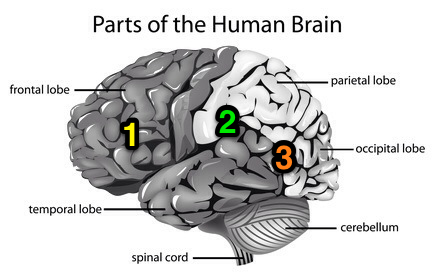
The first area for reading is in the front partof the brain. This area of the brain is known as Brocas area.Brocas area is important in recognizing speech sounds. Speechsounds come in units called phonemes. Words are made up of thesespeech units. The letters of our alphabet stand for these phonemes.The frontal area #1 pictured in the diagram is used for phonemeanalysis. In early reading, students are taught about phonemesounds. This is called phonological awareness. In reading, decodingletters is associated with matching speech sounds to the letters.Understanding the letters and sounds is the first step in reading;this happens in Brocas area.

